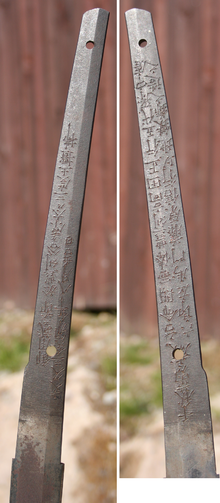Mei (forging)
The Mei ( Japanese 銘 , German “signature”) also Mei-kiri ( 銘 切 り , “signature engraving”) is the signature of a Japanese master swordsmith on the tang ( Nakago ) of a blade.
description
The master blacksmiths often engraved not only their name in the Nakago, but also other information such as place of residence, date of manufacture and client.
Depending on the type of blade, there were differences in the designation:
- Tachi-mei ( 太 刀 銘 ): Since the first tachis , the signature has been attached here in such a way that it points away from the wearer when he was carrying the sword. This is due to the fact that, in contrast to the katana , the tachi were worn with the cutting edge down in the saya. Most swords, daggers, and wakizashi made during the Muromachi period carried a tachi-mei. An exception was the blacksmiths of the Ko-Aoe school, who signed the inside so that the signature pointed towards the wearer when they carried the sword with the edge down.
- Katana-mei ( 刀 銘 ): The katana-mei describes signatures on blades with which the signature points outwards, i.e. away from the wearer when the sword is carried with the edge upwards. All blades that were made after the Muromachi period, almost without exception, have this signature, as well as those made by the Tadayoshi school and master blacksmith Yamashiro no kami Kunikiyo and those who usually always signed their blades with Tachi-mei, such as the Shinshinto smiths of the Suinshinshi school often did.
- Omote-mei ( 表 銘 , "signature on the front"): This term is used when the entire signature is on the front of the blade. This signature contains the address and the title of the blacksmith, especially if the blade was made after the Muromachi period.
- Ura-mei ( 裏 銘 , "signature on the back"): Describes a signature that is exactly on the opposite side of the omote-mei . This signature generally contains the date, the name of the client, etc. Swords intended as gifts for the emperor ( Tennō ) were always signed in Ura-mei.
Craftsmen also left their names in this way on the objects they made or worked on (polishers, tsuba , saya and koshirae manufacturers).
Individual evidence
- ↑ Tamio Tsuchiko: The New Generation of Japanese Swordsmiths. Translated by Kenji Mishina. Kodansha International, Tokyo et al. 2002, ISBN 4-7700-2854-7 . P. 30.
literature
- Kōkan Nagayama: The Connoisseur's Book of Japanese Swords. Kodansha International, Tokyo 1998, ISBN 4-7700-2071-6 .
- John M. Yumoto: The Samurai Sword. A handbook . Tuttle Publishing, Rutland VT et al. 1988, ISBN 0-8048-0509-1 .
Web links
Commons : Japanese Swords - Collection of Images, Videos and Audio Files
